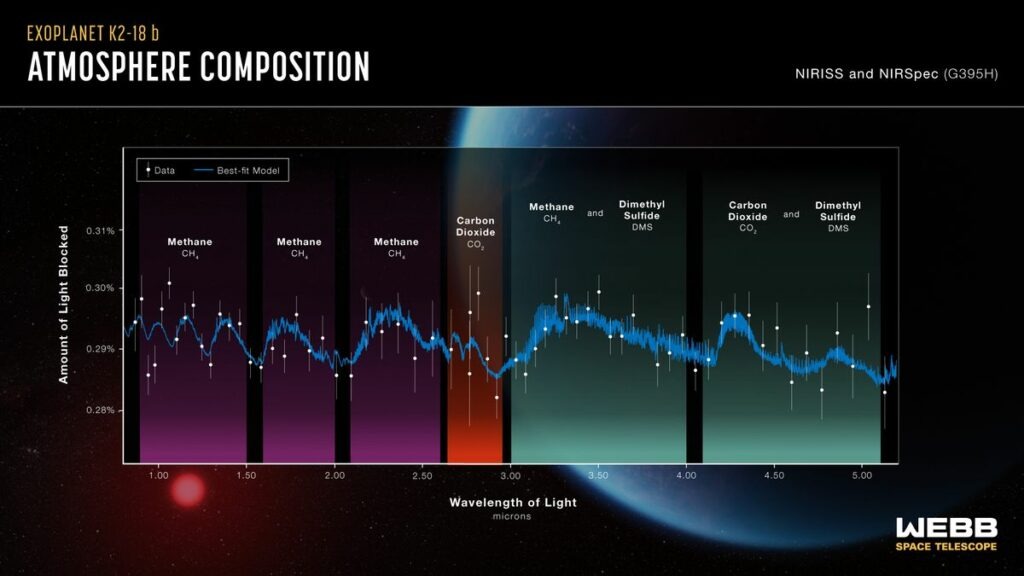The James Webb Space Telescope has discovered that the surface of an exoplanet could be enveloped in vast oceans.
The so-called Hycean planet K2–18 b is around twice the size of Earth and orbits in the habitable zone of a star located 120 light-years from our solar system.
The James Webb Space Telescope (JWST) has discovered evidence of carbon-based molecules in the atmosphere of a suspected ocean world.

The extra-solar planet or exoplanet known as K2–18 b is a tantalizing target for astronomers as they search for life beyond the solar system, as previous research and observations with the Hubble Space Telescope have indicated that the planet could be an ocean or “Hycean” world replete with liquid water — a vital ingredient for life. K2–18 b has a radius between two and three times larger than Earth’s and located 120 light-years away from the solar system.
The new results showed traces of carbon dioxide and methane in K2–18 b’s atmosphere without detecting ammonia, which likely indicates a water ocean under a hydrogen-rich atmosphere.
“Our findings underscore the importance of considering diverse habitable environments in the search for life elsewhere,” research lead author and University of Cambridge scientist Nikku Madhusudhan said in a statement. “Traditionally, the search for life on exoplanets has focused primarily on smaller rocky planets, but the larger Hycean worlds are significantly more conducive to atmospheric observations.”
With mass around 8.6 times that of Earth and located in its cool star’s habitable zone — the region which is neither too hot nor too cold to host liquid water — K2–18 b is an example of a planet with a size between Earth and the solar system ice giant Neptune. These worlds are referred to as “sub-Neptunes” and are unlike any planets in the solar system, which makes them something of a mystery to astronomers, who are currently debating the nature of their atmospheres.
This research should help start to lift the veil surrounding the atmospheres and environmental conditions of both sub-Neptunes and Hycean worlds.
Is this proof of life outside the solar system?
In addition to turning up carbon molecules, the JWST findings also showed the possible presence of something potentially more exciting in the atmosphere of K2–18 b.
The space telescope seems to have detected dimethyl sulfide (DMS), which on Earth is only produced as a by-product of life, mainly created by phytoplankton. The team is cautious about this detection, which is far less certain than the presence of carbon molecules. “Upcoming Webb observations should be able to confirm if DMS is indeed present in the atmosphere of K2–18 b at significant levels,” explained Madhusudhan.
This sense of caution has to be applied to the K2–18 b findings in general when it comes to speculating about alien life. Even if the planet has a liquid water ocean and an atmosphere containing carbon molecules, that doesn’t necessarily mean it harbors life or that the exoplanet could even support living things at all.
With a width of around 2.6 times that of Earth, the planet’s size means its interior contains high-pressure ice similar to Neptune but with a thinner atmosphere and an ocean surface. This means the planet may be boiling away liquid water, making its oceans too hot to host life.
How the James Webb Space Telescope saw right through an ocean world

Assessing the composition of the atmospheres of distant worlds like K2–18 b is no easy task because the light that reflects off their atmospheres is very faint compared to the light from their parent stars. Madhusudhan and the team did this for K2–18 b by waiting for the planet to cross the face of its star from the perspective of the JWST. This means that the light of its parent star shines directly through the atmosphere of the planet.
Chemical elements and compounds absorb and emit light at specific and characteristic wavelengths, which means when they are in the atmosphere of a planet, they leave a distinctive “fingerprint” on starlight — the star’s “spectra” — as it passes through that atmosphere.
“This result was only possible because of the extended wavelength range and unprecedented sensitivity of the JWST, which enabled robust detection of spectral features with just two transits,” Madhusudhan explained. “For comparison, one transit observation with the JWST provided comparable precision to eight observations with Hubble conducted over a few years and in a relatively narrow wavelength range.”
The team’s findings reflect data collected by the JWST during just two transits of K2–18 b across the face of its parent star. More observations of the exoplanet are on the way, but the team behind these findings thinks what they have seen thus far is already proof of the power of the JWST, with just one transit able to deliver as much data as Hubble could reap in eight similar crossings.
The team will now continue to observe K2–18 b with the JWST, and its Mid-Infrared Instrument (MIRI) in particular, as they aim to validate their findings and also gather more intel about the environmental conditions on the exoplanet.
“Our ultimate goal is the identification of life on a habitable exoplanet, which would transform our understanding of our place in the universe,” Madhusudhan concluded. “Our findings are a promising step towards a deeper understanding of Hycean worlds in this quest.”
The team’s research has been accepted for publication in the Astrophysical Journal Letters.
Source: SpaceCom
Do not forget to share your opinion with us to provide you with the best posts !




0 Comments